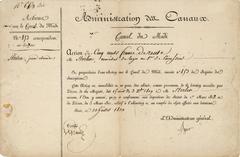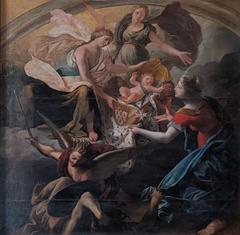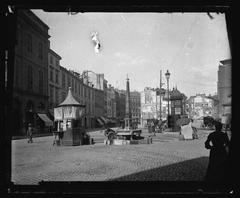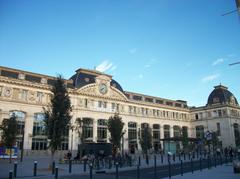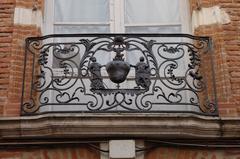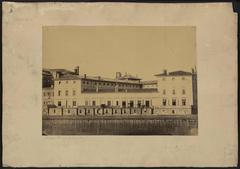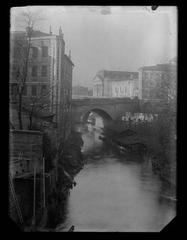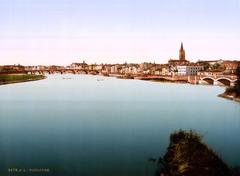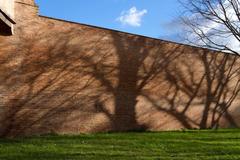Complete Guide to Visiting Rempart Toulouse Allées Jules-Guesde: Hours, Tickets, and Travel Tips
Date: 03/07/2025
Introduction: Discover the Rempart Toulouse and Allées Jules-Guesde
Situated in the heart of Toulouse, France, the Rempart Toulouse along Allées Jules-Guesde stands as a remarkable witness to the city’s multifaceted history. Tracing its origins to Roman times and later serving as the cornerstone of medieval defense, these ancient ramparts are more than just historical artifacts—they are woven into the urban fabric of modern Toulouse. Today, the area around Allées Jules-Guesde offers a unique blend of preserved fortifications, cultural institutions, and lively public spaces.
This guide provides a comprehensive overview of the Rempart Toulouse and Allées Jules-Guesde, covering historical context, practical visitor information, accessibility, nearby attractions, and expert tips to ensure an enriching experience for every visitor. For further details, consult official resources and dedicated heritage sites (Remparts de Toulouse - Wikipedia, Monumentum – Vestiges du rempart médiéval, Toulouse Tourism Official Site).
Table of Contents
- Introduction
- Historical Evolution of Rempart Toulouse
- Visiting Rempart Toulouse: Practical Information
- Notable Remnants and Their Importance
- Allées Jules-Guesde: Attractions & Visitor Experience
- Frequently Asked Questions (FAQ)
- Planning Your Visit: Itineraries and Tips
- Conclusion & Further Resources
Historical Evolution of Rempart Toulouse
Roman Origins and Early Development
The origins of Toulouse’s ramparts trace back to approximately 30 CE, when Roman engineers constructed the first monumental walls around the nascent city of Tolosa. These early ramparts, more symbolic than defensive, showcased the prestige of Toulouse as a Roman colony in southwestern Gaul. Built with characteristic Roman brickwork and impressive scale, their legacy endures in the city’s foundation (Remparts de Toulouse - Wikipedia).
Archaeological Insights
Excavations at sites like Hôpital Larrey and beneath the Théâtre National de Toulouse have revealed foundational trenches and construction pits, confirming the Roman origins and providing a timeline for subsequent modifications.
Expansion in Late Antiquity
By the 4th century CE, political instability in the late Roman Empire prompted considerable fortification enhancements. Defensive towers and extended walls, often employing spolia (reused stone from earlier structures), were built to protect against external threats. Notably, a preserved 70-meter section from this era, maintained by the Musée de l’Institut Catholique de Toulouse, runs parallel to the Garonne River (Remparts de Toulouse - Wikipedia).
Medieval Modifications
Between the 5th and 16th centuries, the ramparts underwent significant changes: medieval towers were added, gates fortified, and wall heights increased. The Allées Jules-Guesde area marks the southern boundary of the former walled city, and street names such as Rue du Rempart-Saint-Étienne echo this heritage.
Preservation and Modern Transformations
Nineteenth-century urban redevelopment led to the demolition of many rampart sections to make way for boulevards like Allées Jules-Guesde. Nevertheless, several remnants, such as the Gallo-Roman tower at Place Saint-Jacques and the Tour des Hauts-Murats, have been preserved and protected as historic monuments (Monumentum – Vestiges du rempart médiéval).
Visiting Rempart Toulouse: Practical Information
Hours and Tickets
- Rempart Toulouse & Allées Jules-Guesde: These are open-air, public spaces accessible 24/7 and free of charge.
- Muséum de Toulouse: General admission is €9 for adults (2025 rate), with concessions for students, seniors, and free entry for under-26s and on the first Sunday of the month (Muséum de Toulouse).
- Other Museums: The Musée de l’Institut Catholique de Toulouse and the Théâtre National de Toulouse offer access to rampart remains during their regular hours. Guided tours may require advance booking and a ticket.
Accessibility & Travel Tips
- Public Transport: Metro (Line B, Carmes), tram (T1), and several bus lines serve the area. VéloToulouse bike-share stations are conveniently located nearby (Toulouse public transport, VélôToulouse).
- On Foot: The site is a short walk from Place du Capitole and the Garonne River.
- By Car: Paid parking is available at Parking Saint-Michel and Parking Carmes.
- Wheelchair Access: The promenade and gardens are wheelchair-friendly, with curb ramps and smooth paths.
Guided Tours and Special Events
- Guided Tours: The Toulouse Tourist Office regularly offers walking tours that include Rempart Toulouse and Allées Jules-Guesde (Toulouse Tourist Office).
- Special Events: Look for the annual Fête de la Science, heritage festivals, and open-air markets along the boulevard (Toulouse events calendar).
Notable Remnants and Their Importance
- Rempart du Bas-Empire: Preserved late Roman walls at the Musée de l’Institut Catholique de Toulouse, notable for their spolia construction and strategic riverside location.
- Tour Rigaud & T.N.T. Remnants: Gallo-Roman defensive structures visible in the basement of the Théâtre National de Toulouse.
- Tour de la rue Jules-Rességuier: A medieval tower with Roman foundations, showcasing centuries of urban adaptation.
- Place Saint-Jacques Remains: Protected Gallo-Roman features uncovered in the 1970s.
These vestiges illustrate Toulouse’s layered history and the evolution of urban defense from antiquity through the Middle Ages (Monumentum – Vestiges du rempart médiéval).
Allées Jules-Guesde: Attractions & Visitor Experience
Key Sights
- Muséum de Toulouse: The oldest natural history museum in France, with exhibitions on biodiversity, evolution, and earth sciences. Open Tuesday to Sunday, 10:00–18:00 (Muséum de Toulouse).
- Jardin des Plantes: A lush botanical garden adjacent to the Muséum, open daily from 7:00 to sunset—ideal for leisurely walks and family outings (Travel2Next).
- Grand Rond & Jardin Royal: Elegant 18th-century public gardens with flower beds, sculptures, and shaded benches.
- Le Quai des Savoirs: A science and innovation center offering interactive exhibitions and workshops, open Tuesday to Sunday, 10:00–18:00 (Toulouse Tourisme).
- Monument aux Morts: War memorial at the northern end of the Allées, a site of civic remembrance.
Amenities and Accessibility
- Food & Drink: Numerous cafés and restaurants along the boulevard.
- Facilities: Public restrooms in parks and museums; accessible paths and seating throughout.
- Markets & Events: The Allées host a lively open-air market every Sunday and frequent cultural events (Haute-Garonne Tourisme – Marché Forain).
Practical Tips
- Best Times to Visit: Spring and autumn for mild weather and vibrant gardens.
- Photography: The ramparts, gardens, and grand plane trees offer excellent photo opportunities.
- Family-Friendly: Playgrounds in the Jardin des Plantes and interactive museum exhibits.
Frequently Asked Questions (FAQ)
Q: What are the visiting hours for Rempart Toulouse?
A: Rempart Toulouse and Allées Jules-Guesde are open-air sites accessible 24/7, year-round, with no admission fee.
Q: Do I need a ticket to visit the ramparts?
A: No ticket is required for the outdoor rampart remains. Museums in the area may charge an entrance fee.
Q: Is the site accessible for visitors with reduced mobility?
A: Yes, the main promenade and gardens are wheelchair-accessible, though some uneven terrain may be present near archaeological features.
Q: Are guided tours available?
A: Yes, guided tours can be booked through the Toulouse Tourist Office and often include Rempart Toulouse and nearby attractions.
Q: How do I reach the site?
A: The area is easily reached by metro, tram, bus, bike, or on foot from the city center (Toulouse public transport).
Q: Can I take photographs or use a drone?
A: Photography is allowed for personal use. Drone use is restricted in central Toulouse—check local regulations (French Civil Aviation Authority).
Planning Your Visit: Suggested Itineraries
- Quick Visit: Stroll along Allées Jules-Guesde and view the rampart remains (30–45 minutes).
- Half-Day: Explore Jardin des Plantes and Muséum de Toulouse for a 2–3 hour outing.
- Full Day: Combine with nearby neighborhoods, markets, and river walks.
Visitor Facilities
- Restrooms: Available at Jardin des Plantes and Muséum de Toulouse.
- Seating: Benches and shaded areas line the boulevard.
- Accessibility: Smooth, wide paths suitable for wheelchairs and strollers.
Safety and Regulations
- The area is well-lit and safe; standard urban precautions apply.
- Dogs are allowed on leashes in public spaces, except inside museums.
- Bicycles and scooters are permitted on designated paths.
Conclusion
Visiting the Rempart Toulouse and Allées Jules-Guesde offers an immersive journey into Toulouse’s past while embracing the vibrancy of its present. The seamless integration of historic fortifications, lush gardens, and cultural institutions makes this area a must-see for anyone exploring the city. Whether you’re seeking historical insight, family-friendly activities, or simply a scenic stroll, this stretch of Toulouse delivers on all fronts.
For the latest updates on events, guided tours, and visitor amenities, consult official tourism resources and consider downloading the Audiala app for tailored audio tours and itinerary planning.
References and Further Resources
- Remparts de Toulouse - Wikipedia
- Monumentum – Vestiges du rempart médiéval
- Toulouse Tourism Official Site
- Muséum de Toulouse
- Haute-Garonne Tourisme – Marché Forain
- Wikipedia – Allées Jules-Guesde
- Travel2Next – Things to Do Toulouse
- French Civil Aviation Authority – Drone Use
- Toulouse Public Transport
- VélôToulouse
Internal Links Suggestion: Consider exploring related articles on “Top Toulouse Historical Sites,” “Toulouse City Walking Tours,” and “Cultural Events in Toulouse” to further enrich your visit.

